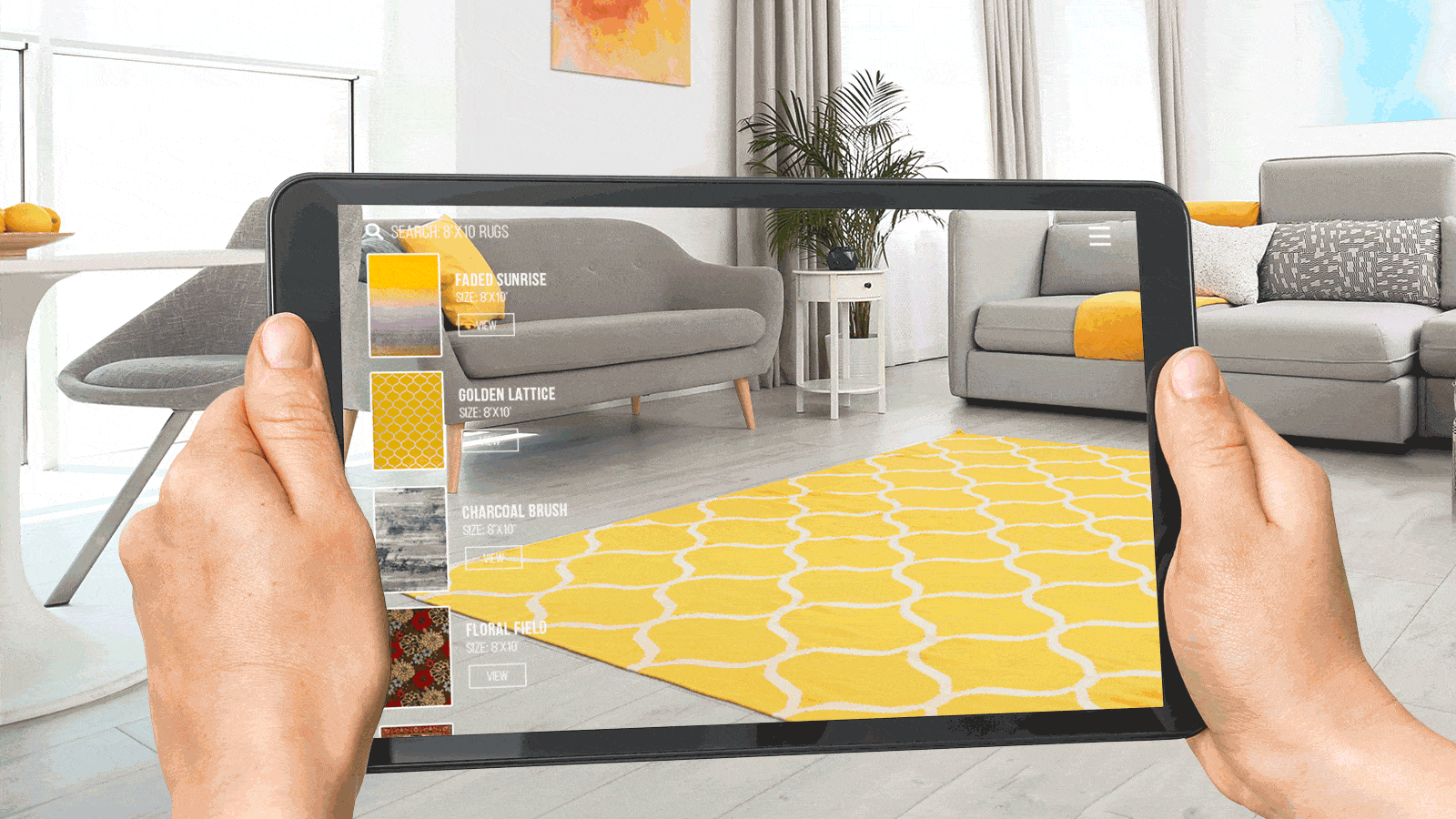Augmented Reality in Retail: The Key to Increased E-Commerce Conversions!
I wonder what the future holds for shopping. Picture a time when you can use your smartphone to take virtual inventory at a store while digital assistants assist you; try on outfits virtually, with no need for wearing them; and, even envision how the living space will be with furniture before you commit to a purchase. This Augmented Reality (AR) in retail is redefining shopping, and it’s not science fiction. Companies employ AR for greater engagement, less return, and personal shopping experiences in retail and online through AR.
What is Augmented Reality(AR) in Retail?
Retailers are beginning to augment the experience of shopping with augmented reality in retail by putting interactivity into the shoppers’ environments. Retail AR is when a layer of digital information is projected over real life to make shopping experiences more fun, more engaging, and also a learning experience in the real world. Since AR puts its users into a virtual reality that cannot be physically seen by humans, AR is more engaging than VR which completely submerges users into a virtual environment. Retailers such as Apple, Nike, Sephora, and IKEA already use AR for a “try before you buy” experience that builds customer confidence and lowers return rates.
What is the Role of Augmented Reality in Retail and E-commerce?
Retailers are starting to adopt augmented reality technology in the pursuit of better engagement, lower returns, and personalized shopping experiences for both in-store and online AR experiences. This is the reason:
Better customer involvement: An interactive customer experience keeps the interest of the consumer for an extra period.
It reduces returns: Through AR technology, customers see the items that are available before they buy them; therefore, they make more informed decisions.
It distinguishes brands: Retail businesses utilizing AR technology stand out in an ultra-competitive retail world.
AR bridges online and offline shopping: AR combines the good of online shopping with that of shopping from a store.
It boosts the conversion rate: 71% of customers prefer stores that feature AR-driven purchasing opportunities, which in turn boosts revenues.
What are the latest AR trends in Retail?
Retailers use AR technology to improve consumer interaction, streamline processes, and provide shopping experiences that are engaging. Some trends affecting AR retail are the following:
More Engaging In-Store Shopping Experience
Retailers employ AR-powered displays and in-store navigation systems to assist their customers to locate products more quickly and receive recommendations specific to their preferences. Retailers such as Marks and Spencer, Harrods, and Next use AR apps in this regard, among others.
Shopping Sizeable Products with AR
Large purchases may be a problem when shopping for big items, such as appliances, furniture, or housewares on the internet. Augmented reality product visualization has become increasingly important to brands that deal with products requiring precise fit and style, such as Wayfair and IKEA. A customer can virtually arrange their living space which enables them to choose which products are needed before they make the purchase.
WebAR: Augmented Reality via Web Browsers
WebAR is a concept of using Augmented Reality through web browsers. Now it allows WebAR shoppers to enjoy immersive Augmented Reality shopping from their mobile browsers, thus eliminating the need to download apps. It makes AR adoption possible for all kinds of devices and simplifies AR purchases.
Experiential Marketing with AR
Retailers are using gamified shopping experiences for AR marketing to engage consumers by playing into their interests and motivations. Tesco is an example of a retailer that turned routine grocery shopping into an interesting experience, building brand loyalty and retention among clients.
Try Before You Buy– Virtual Try-On Solutions
It is probably the most common AR retail application based on the try-before-you-buy idea. Real-time AR overlays provided by Nike and Sephora allow the AR-powered virtual try-on to give a sense of how they would look on customers’ feet, makeup, and spectacles. Purchase confidence is increased and return rates go down with this innovation.
AR Product Configurations for Customization
Customizing is gaining increasing traction with the introduction of AR product configurators that enable instant modification of designs in real time. Buyers will then be in a position to alter designs, colors, and materials, ultimately contributing to greater customer satisfaction and decreased buyer remorse afterward.
Virtual Try-on Technology in the Beauty Industry
The Virtual Try-on Technology is being utilized by brands like Sephora and L’Oréal. This face-mapping AR technology permits their customers to virtually try on different makeup. The virtual try-on technology provides an online cosmetics purchasing experience where the buyers see what color of lipstick, foundation, and eyeshadow appears on their face when it gets sprayed on, therefore raising online sales for this product category.
Route Optimization with AR Navigation
Large stores can be really daunting to get around. This is where AR navigation makes it easier, assisting in guiding the consumer through retail aisles by directing them towards the placement of certain products and featuring in-store promotions catered to the customer’s preferences. A good example of the application of augmented reality for in-store route planning is the Marks & Spencer app.
Interactive AR Packaging for Brand Storytelling
Businesses are starting to leverage interactive AR as a means of spicing up their packaging. 19 Crimes Wine’s labels may now be scanned by their smartphones, launching into animations and storytelling components that build customer connection and brand engagement.
Warehouse Space Optimization with AR
AR technology is being utilized by logistics companies and retailers for warehouse optimization. Using AR-based inventory tracking and space optimization can lead to increased warehouse productivity by cutting errors, streamlining layout, and improving the supply chain.
Placement Previews with AR Visualization
AR-powered placement previews enable consumers to see digital versions of the products in a real-world setting and make purchasing decisions accordingly. Companies like Apple and Vespa utilize AR to give their users a sneak peek of what will come through, and thus, in-store sales have increased with AR in retail stores.
Suggested Read: https://euphoriaxr.com/best-ar-apps-for-interior-design/
Augmented Reality in Retail: Real-World Use Cases
1. An engaging “try before you purchase” experience
Retail stores using AR will allow customers to virtually try on items before they purchase them, which is one of AR’s most helpful benefits for retailers.
Amazon’s AR technology helps customers visualize shoes
Amazon integrated augmented reality visualization features into its shopping app to help customers visualize shoes and how they might appear on their feet when they purchase them. This feature can be used on Amazon AR View to show customers a virtual, life-sized model of the shoe being placed on their feet with movement, and from several angles in real time. Through increasing consumer confidence in products, this technology reduces return rates, as well as improves the overall purchasing experience.
Vanity Planet’s Skin Reporter offers personalized skin care advice.
Vanity Planet has taken another step forward in beauty tech innovation with the Skin Reporter AR tool. Using facial scanning technology, the app analyzes a user’s skin type, tone, and problem areas to deliver personalized, AI-powered skincare recommendations. This interactive experience mimics an in-store consultation and will help customers shop online with increased confidence.
2. Using AR to Gamify in-store shopping
Retails utilize AR-driven gamification to make the buying experience interactive and engaging.
Tesco’s gamification of shopping transforms shopping into an adventure.
Have changed trips to the supermarket into exciting activities thanks to Tescos redefining the conventions of shopping? Using the supermarket’s augmented reality (AR)-enabled mobile app, consumers can forage through scavenger hunts, earn instant wins, and uncover secret offers with a scan of a barcode. Wanting to only increase consumer engagement, and encourage return business and this loyal relationship with a brand.
Using AR to add a festive touch to the 19 Crimes wine brand.
The 19 Crimes wine brand redefined the entire wine market with the use of AR-enabled labels. Use your smartphone to scan the label and historical criminals printed on the wine bottles can come to life and tell their stories to customers. This augmented reality integration instantly sets the wine bottle apart by incorporating a narrative aspect to the product, making an emotional connection with consumers.
3. Creating a Memorable brand identity
Branding is not just a logo, it is all about creating a unique and well-remembered experience.
Overly app partners with creative agencies to produce AR-driven Christmas experiences
Overlyapp had teamed up with global agencies to produce Christmas time AR shopping experiences. They range from interactive Christmas cards, virtual Santa experiences, to digital holiday overlays that make the purchase more enjoyable and engaging. Incorporating augmented reality into Christmas advertisements provides brands with the chance to build an emotional connection with consumers.
Aizputes Vīns collaborates with Overlyapp to bring a festive AR experience
A combination of Overlyapp and Aizputes Vīns brand has released an augmented reality-driven immersive Christmas ad. When customers scanned the wine bottles, they could see interactive graphics, animations with a holiday theme, and personalized greetings, making gift-giving more special and memorable.
4. Virtual Navigation and in-store displays
AR is changing the way consumers interact with retail locations and walk around within them.
PacSun: AR storefront display and virtual try-on
Fashion brand PacSun outfitted its stores with AR-powered storefront screens that let shoppers try on clothing virtually before they walk through the door. Smartphones and AR-enabled mirrors allow customers to see how different clothes look on them almost instantly, enhancing the shopping experience and removing the bother of fitting rooms.
Marks & Spencer’s AR app makes it easy for customers to navigate supermarkets.
Marks & Spencer just launched an augmented reality (AR) supported navigation app to help customers find things in its stores. It allows customers to have explicit guidance on the in-store experience of products on their shopping list instead of going aimlessly through aisles. As a result, the shopping experience is optimized, your store becomes more efficient, and irritations are minimized.
Is your retail company prepared for what lies ahead? E-commerce is being reformed by EuphoriaXR’s AR solutions. Learn how to incorporate AR right now.
The Stats Behind Augmented reality in retail
The following stats are compelling proof that AR is making an impact on retail:
Consumer Preference for AR Shopping: 72% of consumers claimed they would be interested in stores that offer AR experiences Reydar.com.
Reduction in Return Rates: Since an informed purchase, retailers adopting AR visualization technology have witnessed a 40% decrease in product return rates.
AR Retail Experiences Increase Purchase Intent: Augmented reality (AR) has been shown to increase purchase intent among consumers by 17% in retail settings, suggesting AR experiences can influence purchase decisions. (Source: Reydar.com)
Expected AR Growth in the Retail Sector: The global AR retail market, which amounted to $2 billion in the year 2021, is projected to expand to $61.3 billion in the year 2031 owing to the growing utilization of AR technologies in retail.
Increase in user willingness to pay: Increased value that AR adds to the shopping process: For example, 40% of consumers would pay more for a product if they could try it with augmented reality.
Brands Utilizing Augmented Reality in Retail
Already, many leading brands are implementing augmented reality (AR) technology to diversify the shopping journey by using personalized, interactive, and immersive retail solutions. Here are a few examples of how some of the top brands are using AR in retail:
Wayfair– AR for Virtual Home Decor Placement
Wayfair View in Room 3D, a technology that is AR-powered and lets buyers visualize furniture in their environment prior to purchase, has changed furniture online shopping completely. With exact digital images of sofas, tables, and other furniture placed in the user’s actual home, this solution boosts customer confidence.
Key feature: “View in Room” AR feature in mobile apps.
Impact: It improves online furniture shopping experiences and lowers return rates.
L’Oreal– Virtual Beauty Try-On with AR
By using the ModiFace application customers can virtually test L’Oreal makeup products through their smartphone camera’s real-time functionality during online shopping. The superiority of the face feature mapping allows customers to examine many different shades of lipstick foundation and eyeshadow before buying.
Key feature: ModiFace Virtual Try-On.
Impact: The application leads to restricted testing limitations and higher consumer trust when shopping online.
Nike – Virtual Try-On for Sneakers
Through Nike Fit users can identify their perfect shoe size by letting this augmented reality (AR) foot-scanning app measure their foot dimensions using their smartphone camera. The size problem experienced by online shoppers when purchasing shoes should be resolved by this feature.
Key Feature: Nike Fit AR Foot-Scanning Technology.
Impact: The implementation of this feature ensures better convenience for customers while reducing the number of size-related return cases.
Apple– AR Shopping & Product Visualization
Customers gain access to three-dimensional product viewing of iPhones, iPads, and MacBooks through Apple’s augmentation of its retail technology base for shopping. The ARKit technology developed by the company allows retail developers to create Augmented Reality Experiences through retail apps.
Feature: The Apple Store app’s AR Quick Look feature.
Impact: Through the implementation of this feature Apple provides customers with realistic product previews of its products.
IKEA– AR Furniture Placement & Customization
The IKEA Place App allows users to experience 3D models of furniture through augmented reality before they buy anything by letting them virtually place the objects in their homes’ spaces. IKEA amplified its augmented reality capabilities by providing customers the opportunity to customize their products with different materials and colors and diverse sizes.
Feature: The IKEA Place App.
Impact: The user experience becomes better due to improved customer confidence and visualization during the purchasing process.
Vespa– AR for Vehicle Customization & Showroom Experience
Real-time augmented reality technology allows customers to see scooter models and make personalizations through Vespa’s platform. Through their application, customers can personalize their purchases by choosing color combinations and accessories along with virtually placing the Vespa model in their garage or driveway space.
Main feature: Vespa Showroom & Customization Tool powered by AR
Impact: The technology creates two positive effects by strengthening brand dedication among customers and improving trust in their buying decisions through interactive design previews.
Topshop– AR-Powered Virtual Dressing Rooms
Topshop consumers gain the ability to preview clothing through AR-powered fitting room technology which enables virtual dressing before they purchase any item. Shoppers inspect various clothing fits by using gesture motions to activate AR-powered interactive digital mirrors that predict their appearance.
Main feature: AR dressing rooms in retail establishments
Impact: Consumer experience is enhanced while shopping time accelerates in retail locations because of this development.
Sephora– AI and AR-Driven Virtual Makeup Try-On
Sephora employs augmented reality and artificial intelligence to operate the Virtual Artist system which transforms the beauty retail market through virtual makeup testing for customers. Customers can attempt different color and style choices with this technology so they can make unhappier purchases and returns unlikely.
Key feature: Sephora Virtual Artist
Impact: Virtual try-on technology enhances customer experience thus leading to increased online conversion rates.
Adidas– AR Shoe Try-On & In-Store Experience
Adidas uses its mobile app along with its flagship shops to provide augmented reality technology which allows users to do virtual sneaker testing and view product details. Through the use of shoe model scanning customers can verify their sneaker fit before making a purchase.
Main feature: Using the Adidas App to try on AR sneakers
Impact: The implementation enhances interactions with customers and fixes the issue of poorly fitted products.
How to implement AR in the in-store
Select the Use Case: Decide whether customers should interact with products through packaging (19 Crimes Wine) or use IKEA and Wayfair to visualize products and Nike and Sephora to perform virtual try-ons or Marks & Spencer for navigational purposes.
Choose AR technology: The implementation consists of choosing AR technology either through smart glasses or WebAR capability AR Mirrors or mobile applications. The most accessible is WebAR.
Incorporate AR solutions: The implementation of AR solutions should use ModiFace and Vuforia as well as Instagram and Snapchat filter applications.
Assure Omnichannel Presence: Customers need seamless transitions between platforms so ensure universal AR applications across websites and mobile devices as well as retailers and social networks.
Enhance User Experience: The system should have an efficient onboard process that combines fast performance with easy usability features throughout the experience.
Train & Educate: Staff leaders should educate both clients and personnel by providing marketing materials and step-by-step demonstrations and tutorials.
Measure & Improve: The assessment of returns and engagement together with conversion statistics enables businesses to enhance their AR approach.
Real-World Cases of Boosted Customer Experiences by Incorporating AR in Retail
Use Case1. Using AR to Advance Cabin Manufacturing:
Augmented reality is transforming the cabin manufacturing sector through the capability it gives designers and clients to preview cabin layouts as well as materials and customization options before manufacturing begins.
AR Use:
Customers can observe various configuration appearances through real-time 3D visualization by putting digital cabin models into their actual location.
The system enables users to change colors as well as materials and layouts for a truly customized design process.
The convergence of buyers’ expectations with those of manufacturers enables AR to improve production performance through diminished design problems that save manufacturing costs.
Impact:
Realistic preview software enabled by the system boosted client satisfaction.
Transaction speed improves when designers receive more precise design information.
Since production mistakes decreased fewer resources were needed as well as less time.
Use Case2. AR Powered Apps for E-Commerce:
Through augmented reality (AR) capabilities e-commerce businesses enable their users to view products directly in their actual settings and support customers through purchasing choices.
AR Use:
Users can test clothes, shoes, and makeup products virtually from Nike Sephora, and L’Oréal before purchasing them directly from the fashion and beauty brands.
The AR-enabled shopping applications of Wayfair and IKEA permit customers to place furniture and home decorations inside their residences before buying.
Digital AR labels from 19 Crimes Wine, and other companies enable users to scan packaging which activates narrative-driven storytelling features that animate product containers.
Impact:
Better sales conversion rates occur because customers develop more assurance about their purchase decisions.
The capability for consumers to make better purchasing decisions leads to decreased return rates. Such improvements in brand engagement result in more engaging and interactive shopping experiences.
Strategic Financial Planning for AR Integration
Retailers need to assess the long-term benefits, ROI, and expenses using AR.
AR success depends on investments made for software systems as well as hardware systems and development initiatives.
Training employees to increase adoption
Strategies that involve customer engagement focus on maximizing the impact of AR technology
The lasting accomplishment of systems requires attention to both scalability components and maintenance procedures.
Challenges of Implementing AR in Retail
High Initial Costs: Creating AR features necessitates spending money on hardware, software, and app development.
Customer Adoption: Customers require marketing and educational measures to adopt AR since some of them lack familiarity with this technology.
Integration with Current Systems: A vital integration requirement involves establishing direct links between AR applications retail store systems and online storefronts.
Device Compatibility: Accessibility is limited because certain customers do not own devices that support AR technology.
EuphoriaXR’s AR-enabled Applications for Retailers
EuphoriaXR operates as a top Augmented Reality Development Company that provides retailers with innovative augmented reality technology solutions to elevate customer satisfaction and drive business expansion.
Important AR Solutions from EuphoriaXR:
Interactive Product Visualization: The display of complete 3D product representations realistically placed within their environments helps consumers gain assurance for their buying choices.
AR test-on Experiences: By allowing customers to virtually test items before purchasing, fashion, cosmetic, and eyewear companies can lower return rates.
Immersion In-Store Navigation: AR-powered maps improve convenience by assisting customers in finding products fast.
Gamified Shopping & AR Marketing: Stores can enhance customer participation through gamified shopping systems and marketing methods that use AR technology.
Retailer Impact:
Customer conversions improve when companies demonstrate products realistically in their digital versions.
Customers who have a thorough understanding when selecting products make returns less likely.
Customers establish stronger branding bonds when they experience augmented reality interactions in immersive ways.
Augmented Reality Reshaping eCommerce!
E-commerce is changing as a result of augmented reality (AR) in retail, which makes online purchasing more engaging and customized. Users can experience unmatched convenience through WebAR because it enables them to produce AR connections without installing new browser applications. The AI-based AR recommendation system provides featured product recommendations to customers leading to enhanced overall satisfaction.
The evaluation of 360-degree product views through augmented product demos enables customers to choose better items. Users can increase social commerce purchases through Instagram and Snapchat by accessing virtual try-on AR filters. Digital retail experiences are transformed by AR technology because companies use it to enhance consumer interaction while lowering the number of returns and increasing customer loyalty.
Frequently Asked Questions(FAQs)
How does AR in retail increase sales?
AR increases client confidence, decreases hesitancy to buy, and boosts engagement, all of which increase conversions. Brands that use AR report longer session durations and higher cart values.
Is AR a powerful sales channel for retailers?
Yes! AR shopping experiences help firms stand out, draw in tech-savvy customers, and provide engaging shopping experiences that increase sales and customer loyalty.
What industries are leveraging AR in retail?
The following industries make extensive use of AR:
Fashion & Beauty: Virtual try-ons for apparel, accessories, and makeup (Nike, Sephora, L’Oréal)
AR-powered placement previews: For furniture and home décor (IKEA, Wayfair)
Automotive: AR showroom experiences and automobile configurators (Vespa)
Apple Consumer Electronics: Interactive Augmented Reality Product Demos

















